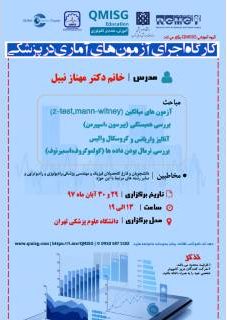Course Description
Program Objective
General Program Outline
Target Audience
Teachers
Date & Location
Course Description
In Statistics Course, basics of statistics will be described briefly. Then, statistical testing methods in both parametric and nonparametric manners will be practically taught, utilizing MINITAB software (version 18.1). Examples are mostly related to biomedical applications to give the ability to the audience how to choose some tests rather than others.
Program Objective
The aim of Statistics Course is to grow the knowledge of using statistical techniques, as well as obtaining the test results by at least one software. Also, outputs will be discussed to teach attendees how they can gain confidence in the accuracy of results.
One of the main concerns in statistical tests is their assumptions. Therefore, checking these assumptions is the most important part of each test which often is neglected by researchers, as the significance is computed based on the correctness of these assumptions. In this course, providing these assumptions is exhibited and if they are not satisfied, the ways of data modification will be taught.
After completion of this training program, the attendees will be able to:
One of the main concerns in statistical tests is their assumptions. Therefore, checking these assumptions is the most important part of each test which often is neglected by researchers, as the significance is computed based on the correctness of these assumptions. In this course, providing these assumptions is exhibited and if they are not satisfied, the ways of data modification will be taught.
After completion of this training program, the attendees will be able to:
- Understand the basics of statistical methods and select the proper test
- Learn how to perform a statistical hypothesis test
- Understand how to interpret the output of MINITAB software
- Understand the necessity of testing assumptions and verify them
- Learn some methods to transform a data set into one which is satisfied under hypothesis assumptions
General Program Outline
- Basics of statistics
- Statistical hypothesis testing terminology
- Parametric tests such as one sample mean (z or t-test), one sample variance (), a testing proportion of an occurrence, correlation test, paired t-test, one-way ANOVA
- Checking the assumptions of statistical tests
- Checking normality assumption and transforming non-normal data into normal ones
- Non-parametric tests such as a sign, Mann-Whitney, Wilcoxon sign-ranked tests
- Checking the correlation of variables using Pearson, Spearman or other correlation coefficients
- Testing randomization of a data set
- Checking equality of means in more than two populations using Kruskal-Wallis test
- Describing the relationship between parametric tests and the non-parametric ones (the corresponding relation between them will be shown graphically)
Target Audience
- Students and Graduates biomedicine, biology, biophysics,
- Students and Graduates of any engineering major such as electronic, computer, HSE (health, safety, and environment),
- Researchers who need to apply statistical techniques in their researches.
Teachers
- Dr. Mahnaz Nabil, Ph.D. of Statistics,
- Assistant Professor of Statistics, Department of Mathematical Statistics, Guilan University.
- Research Associate of QMISG
Date & Location
Date: 1:00 pm To 7:00 pm | 97/8/29 – 97/8/30
Location: Conference Room, Research Center for Molecular and Cellular Imaging, Kaboli Building, Emam Khomeini Hospital, Keshavarz Boulevard, Tehran, Iran.
Location: Conference Room, Research Center for Molecular and Cellular Imaging, Kaboli Building, Emam Khomeini Hospital, Keshavarz Boulevard, Tehran, Iran.

